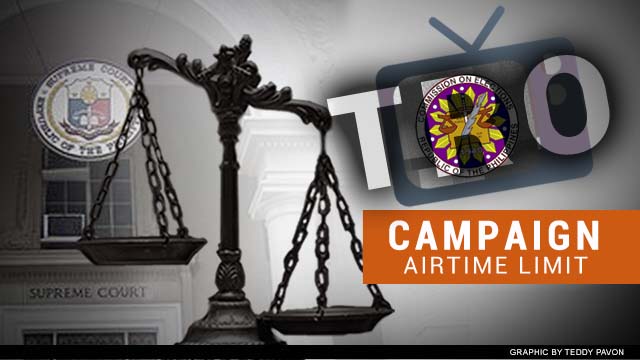SUMMARY
This is AI generated summarization, which may have errors. For context, always refer to the full article.

MANILA, Philippines – The Supreme Court clarified on Thursday, April 18, that it issued a temporary restraining order — not a status quo ante order (SQAO) — on the aggregate airtime limits set by the Commission on Elections.
Theodore Te, head of the SC Public Information Office, earlier told reporters on Tuesday, April 16, that the SC issued a SQAO, which reinstates the airtime limits for candidates of 120 minutes and 180 minutes for each television and radio station, respectively. The Comelec had earlier ruled that the airtime limits were supposed to be on an aggregate basis.
An SQAO is issued when the act sought to be restrained has already been done. It therefore serves to “undo” the act. A TRO, on the otherhand, prevents the implementation of any policy or law.
Lawyer Marlon Manuel, however, said there is hardly a difference between the two. “In terms of effect, wala. For me, it’s just a matter of terminology, (In terms of effect, there is no difference between a TRO and a status quo ante order).”
The SC, in its decision on Dojillo v. Commission on Elections, also said a status quo ante order has “the nature of a temporary restraining order.”
Te apologized for the mistake, saying he assumed wrongly that the SC issued a status quo ante order.
“I was told of the order and that the status quo as of 2010 was to be observed. I assumed, wrongly, that the SC was issuing a SQAO. That later the SC issued a TRO is certainly beyond my control,” he said.
“I apologize for the confusion and the error, the mistake is mine.”
Ceiling
The SC, voting 9-6, issued the TRO stopping the Comelec from implementing Comelec resolution no. 9615, which states that, “Not more than an aggregate total or 120 minutes of television advertising, whether appearing on national, regional, or local, free or cable television, and 180 minutes of radio advertising, whether airing on national, regional, or local radio, whether by purchase or donation” will be allowed per candidate.
The Comelec, under chairman Sixto Brillantes Jr, wanted to compute the airtime for the political ads as an aggregate to level the playing field for all candidates and to adhere to the spirit of the Fair Elections Act. (Read: Why revert to old airtime cap for candidates).
Broadcast networks GMA-7, TV5 and the Kapisanan ng mga Brodkaster ng Pilipinas asked the High Court to stop the Comelec from enforcing the aggregate airtime limits because it allegedly violates the people’s right to information. Brillantes shot back at them, however, and said their oppositon is based on their need to make a profit as networks earn revenues from political ads.
Sen Alan Peter Cayetano also intervened in the case, saying the aggregate airtime limit on campaign ads would limit the voters’ opportunities to know the candidates.
Brillantes threatened to resign over the High Court’s ruling, but later said he will ask the SC to immediately resolve the case on its merits. – Rappler.com
Add a comment
How does this make you feel?
There are no comments yet. Add your comment to start the conversation.